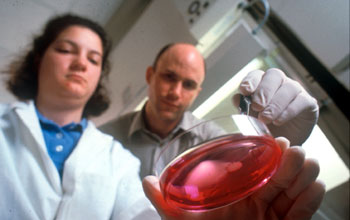Multimedia Gallery
Developing clinically effective constructs
A research team at the Georgia Institute of Technology uses an approach in which they attempt to mimic the natural process of bone repair by implanting cartilage constructs, created in an incubator, into bone defects.
More about this image:
U.S. National Science Foundation-supported researcher Robert Guldberg and his team at Georgia Tech are developing clinically effective constructs to replace or restore damaged bone and cartilage. Cartilage is bone's natural scaffold during a process called endochondral ossification, which is responsible for bone development, growth and fracture healing.
Also being developed are biomaterials that use genetically modified cells or bioactive scaffolds to stimulate the repair of defects caused by injury or diseases like osteoporosis and osteoarthritis. Guldberg and his team hope that ultimately this technology will help lead to future advances in next-generation orthopedic implants.
Guldberg is also investigating the possibility of mechanically stimulating a bone graft repair by applying controlled, intermittent force using an in vivo hydraulic bone chamber system. Understanding how mechanics influences the repair of tissue-engineered constructs would provide microstructural design objectives for manufacturing effective biomaterial scaffolds. (Year of image: 2000)
Credit: Photo by Gary Meeks
See other images like this on your iPhone or iPad download NSF Science Zone on the Apple App Store.
Images and other media in the National Science Foundation Multimedia Gallery are available for use in print and electronic material by NSF employees, members of the media, university staff, teachers and the general public. All media in the gallery are intended for personal, educational and nonprofit/non-commercial use only.
Images credited to the National Science Foundation, a federal agency, are in the public domain. The images were created by employees of the United States Government as part of their official duties or prepared by contractors as "works for hire" for NSF. You may freely use NSF-credited images and, at your discretion, credit NSF with a "Courtesy: National Science Foundation" notation.
Additional information about general usage can be found in Conditions.
Also Available:
Download the high-resolution JPG version of the image. (456 KB)
Use your mouse to right-click (Mac users may need to Ctrl-click) the link above and choose the option that will save the file or target to your computer.

 All images in this series
All images in this series